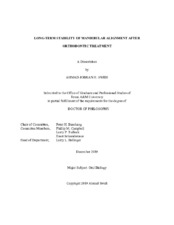| dc.description.abstract | The objectives of the present study were first, to synthesize the literature pertaining to post-treatment mandibular alignment changes, second to evaluate post-treatment mandibular growth and dentoalveolar changes, third to assess the relationship between mandibular incisor mesiodistal angulation and alignment changes, and finally, to evaluate treatment and posttreatment changes of mandibular anterior teeth rotation and curve of Spee leveling.
The first study was a systematic review and meta-analysis that assessed the orthodontic literature pertaining to post-treatment mandibular alignment. The second study evaluated mandibular growth and dentoalveolar changes, using cephalometric radiographs of 100 orthodontic patients treated with four premolar extractions and followed-up an average of 19 years. The third study used panoramic radiographs and orthodontic models from the previously described sample to assess the relationship between mandibular incisors distal root tip and alignment changes. The fourth study used orthodontic models of the patients in the second study to assess post-treatment relapse of orthodontically rotated anterior teeth and curve of Spee leveling. The first study showed that post-treatment mandibular irregularity increases are limited, with slightly greater increases in patients treated with premolar extractions and in patients followed up over longer periods. The second study showed substantial amounts of post-treatment mandibular growth, which was greater in males than females, and in younger than older patients. It also showed that the dentoalveolar changes were affected by the retention method used and extraction patterns. The third study confirmed that post-treatment mandibular alignment changes were limited. It also showed that the mandibular incisors finished treatment with slight distal root tip, and exhibited minimal post-treatment changes. There was no relationship between mandibular incisors angulation at the end of treatment and mandibular alignment changes. The fourth study showed that there was post-treatment relapse of the rotational and COS changes that occur during treatment. The mandibular lateral incisors were most likely to relapse. | en |


